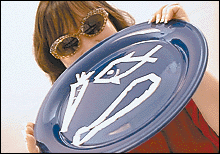


The Weekly Eater

Let's face it, in a high-tech world it's only natural for human beings to want to retreat. By day we may have no choice but to surround ourselves by boxy computers blasting us with gamma rays and plastic cell phones emitting microwaves, but by night the picture seems to indicate we crave more pleasant sensations: long massages in rooms lit by candles and scented with essential oils, against a backdrop of water gurgling from a plug-in tabletop fountain (what can I say? - few would want to banish technology from their lives completely). Miyako Restaurant
is a savory work of art
at the New OtaniA renewed interest in the way of tea, spa pampering and the discipline of yoga represents a longing for ritual that clears the mind, grounds the body and connects the soul to a greater entity.
In cuisine there are few rituals more elaborate than that of the Japanese traditional dinner called kaiseki. Winter, spring, summer or fall - all you have to do to find out the time of year is to peek into Miyako Restaurant in the New Otani hotel, where its kaiseki pays loving homage to the seasons.
For many, grab and go is the modus operandi at meal time. They barely look at the food in their fist before gulping it down. Not so with the kaiseki. Diners must take the time to sit back and take note of the chef's attention to shape, texture, symmetry and color, not only of the food, but of the utensils and garnishes.
MIYAKO RESTAURANT
Food Service 1/2
Ambience 
Value 1/2
Address: The New Otani, 2863 Kalakaua Ave./ 923-4739
Hours: 5:30 to 9:30 p.m.
Cost: About $45 to $80 for two, without drinks
The kaiseki is not much different in principle from the art forms of ikebana, bonsai or feng shui. Just as bonsai plants are miniature re-creations of ancient forest trees, so does the kaiseki chef try to reflect Japan's islands, mountains, forests and the ocean - a world on a plate.
For a while, patrons feared that Miyako's kaiseki would disappear with a change in personnel in April. Not to worry; the New Otani moves its chefs around every few years to bring in new eyes and ideas.
New chef Hidenobu Oishi is finding new inspiration in our local produce but is sticking with the Japanese seasons for the sake of variety. The Minazuki (June) Kaiseki, $32, marks Japan's rainy season. Therefore, ahi and shiromi (snapper) sashimi are given a protective umbrella of a taro leaf which frames the raw fish and an accompanying pagoda of wasabi.
There are eight courses. Start with a splash of shrimp, okra, mushrooms and potatoes engulfed in slippery, sloshy bubbles of gelatin. It's the sort of dish that could only be popular with those who grew up liking such gooey goodies as okra and araimo.
This is followed by a mini-salad of green onions and three pieces of tako topped by a light mustard dressing.
Next up is the all-important unagi, which is layered upon tofu and a slice of tomato. The broiled freshwater eel is painted over with a basil pesto. June is also a time of energy-zapping heat in Japan, and to combat a national malaise, the hottest day of the year is designated Eel Day (actually, 18 days before the start of autumn by the lunar calendar), when everyone must get on down to the nearest eel shop to munch on a few specimens. The eel is believed to possess enough restorative properties to give people the strength to last through summer.
The next dish was a fabulous ball of taro manju, capturing the dusty lilac of the hydrangea and dusted with crumbled bits of puffed rice, forming little white "blossoms" on the purple, and a center of cubed mochi.
Working backward from local-style dining, this was about the time the rice and red miso soup arrived. Heaven forbid filling guests up with such plain fare before introducing the meal's main attractions. They're right, of course. By this time I was too full to eat much rice, and dessert, thankfully, was a manageable and refreshing coffee gelatin with a couple of slices of cinnamon banana.
If all this sounds like too much bother and mystic mumbo jumbo, Miyako isn't just for aesthetes. Those who prefer food as sustenance will find more earthy than ethereal qualities in the rice dish salmon chazuke ($8) and substantial shrimp and vegetable tempura ($9.50). And definitely not to be missed is the Miyako-style steak ($18), sirloin, dredged in a bit of flour and cornstarch and then deep-fried and served on a sizzling platter with a ponzu-garlic sauce. With a couple of side dishes, the steak could be the centerpiece to a wonderful shared meal for two.
Apparently, brunch or lunch at Hau Tree Lanai downstairs is not the only reason to visit New Otani. If you do call, make an early reservation so you can catch the sunset over Waikiki from the restaurant's second-floor balcony.
See some past restaurant reviews in the
section online. Click the logo to go!
Nadine Kam's restaurant reviews run on Thursdays. Reviews are conducted anonymously and paid for by the Star-Bulletin. Star ratings are based on comparisons of similar restaurants:
To recommend a restaurant, write: The Weekly Eater, P.O. Box 3080, Honolulu, Hawaii 96802. Or send e-mail to nkam@starbulletin.com
excellent; very good, exceeds expectations; average; below average.